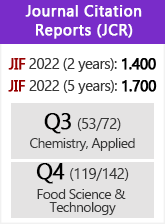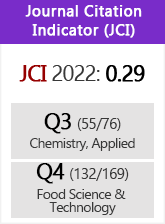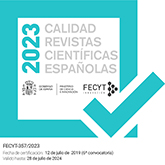Enzymatic preparation and characterization of soybean lecithin-based emulsifiers
DOI:
https://doi.org/10.3989/gya.0571161Keywords:
Concentrated lecithin, Glycerolyzed lecithin, Hydrolyzed lecithin, Lysolecithin, Powdered lecithinAbstract
Simple enzymatic methods were developed for the synthesis of lysolecithin, glycerolyzed lecithin and hydrolyzed lecithin. The products were characterized in terms of their acetone insoluble matter, hexane insoluble matter, moisture, phospholipid distribution and fatty acid composition. The HLB value ranges of different products with different acid values were detected. The efficiency of optimally hydrolyzed lecithin was examined at high calcium ion, low pH, and aqueous solutions and compared with commercially available standard lecithin-based emulsifiers. Overall, lysolecithin powder was proven to be the best emulsifier even at strong and medium acidic conditions.
Downloads
References
Aliqian Y, Harjinder S. 2001. Interfacial composition and stability of sodium caseinate emulsions as influenced by calcium ions. Food Hydrocolloids 15, 195–207. https://doi.org/10.1016/S0268-005X(00)00065-5
AOCS. 2001. In: DEFirestone (Ed.) Official methods and recommended practices of AOCS (4 th ed.) Illinois: The American Oil Chemists Society AOCS Press.
Aoi N. 1990. Soy lysolecithin. Yukagaku 39, 10–15. https://doi.org/10.5650/jos1956.39.10
Aura AM, Forssell P, Mustranta A, Suortti T, Poutanen K. 1994. Enzymatic hydrolysis of oat and soya lecithin: Effects on functional properties. J. Am. Oil Chem. Soc. 71, 887–891. https://doi.org/10.1007/BF02540468
Becart J, Chevalier C, Biesse JP. 1990. Quantitative analysis of phospholipids by HPLC with a light-scattering evaporating detector - application to raw materials for cosmetic use. J. High Resol. Chromatog. 13, 126–129.
De Maria L, Vind J, Oxenbøll KM, Svendsen A, Patkar S. 2007. Phospholipases and their industrial applications. Applied Microbiol. Biotechnol. 74, 290–300. https://doi.org/10.1007/s00253-006-0775-x PMid:17221199
Duin H, Westdorp P, Weiske Th, Reissmann W. 1963. Phosphatide antispattering agent for margarine. British Patent 1491952.
Erickson MC. 2008. Chemistry and function of phospholipids In: Akoh CC, Min DB (eds) Food lipids: chemistry nutrition and biotechnology, Chapter 23rd. edn. CRC Press Boca Raton, 39–62. https://doi.org/10.1201/9781420046649.ch2
Estiasih T, Kgs, Ahmadi Ginting E, Priyanto AD. 2013. Modification of soy crude lecithin by partial enzymatic hydrolysis using phospholipase A1. Int. Food Res. J. 20, 843–849.
Fujita S, Suzuki K. 1990. Surface activity of the lipid products hydrolyzed with lipases and phospholipase A2. J. Am. Oil Chem. Soc. 67, 1008–1014. https://doi.org/10.1007/BF02541867
Gupta RK, James K, Smith FJ. 1983. Sucrose esters and sucrose ester/glyceride blends as emulsifiers. J. Am. Oil Chem. Soc. 60, 862–869. https://doi.org/10.1007/BF02787451
Haas MJ, Scott K, Janssen G.1994. Enzymatic phosphatidylcholine hydrolysis in organic solvents: An examination of selected commercially available lipases. J. Am. Oil Chem. Soc. 71, 483–490. https://doi.org/10.1007/BF02540658
Haas MJ, Cichowicz DJ, Phillipis J, Moreau R. 1993. The hydrolysis of phosphatidylcholine by an immobilized lipase optimization of hydrolysis in organic solvents. J. Am. Oil Chem. Soc. 70, 111–117. https://doi.org/10.1007/BF02542611
Hirai H, Sono R, Koh H. 1998. Process for manufacturing vegetable lysolecithins. European Patent EP0870840.
Hoof C.'t, Van den Kommer M, Segers JC. 2005. Food composition suitable for shallow frying comprising sunflower lecithin. European Patent EP1607003.
Kim JK, Kim MK, Chung GH, Choi CS, Rhee JS. 1997. Production of lyso phospholipid using extracellular phospholipase A1 from Serratia SpMK1. J. Microbiol. Biotechnol. 7, 258–261.
Kudo S, Nishi E. 1990. Surfactant and process for producing the same PCT. International Appl. WO 90 11 823.
Mustranta A, Forsell P, Poutanen K. 1995. Comparison of lipases and phospholipases in the hydrolysis of phospholipids. Process Biochemistry 30, 393–401. https://doi.org/10.1016/0032-9592(94)00030-1
Nakai E, Suzuki K, Sato S, Kato M. 1988. Method for enzymatic decomposition of phospholipid. Jpn. Kokai Tokkyo Koho JP 63 044 883.
Nieuwenhuyzen WV, Tomas MC. 2008. Update on vegetable lecithin and phospholipid technologies. European J. Lipid Sci. Technol. 110, 472–486. https://doi.org/10.1002/ejlt.200800041
Nieuwenhuyzen WV. 1981. The industrial uses of special lecithins. J. Am. Oil Chem. Soc. 58, 886–888. https://doi.org/10.1007/BF02659651
Sarney DB, Fregpane G, Vulfson EN. 1994. Lipase-catalyzed synthesis of lysophospholipids in a continuous bioreactor. J. Am. Oil Chem. Soc. 71, 93–96. https://doi.org/10.1007/BF02541478
Schmitt H, Heirman M, Brüse F, Schneider M, Van Der Sype J. 2005. Enzymatic production of hydrolyzed lecithin products. WIPO Patent Application WO/2005/100579.
Seung JC, Eric AD, Lulu H, Popplewell LM, Hang X, David JM. 2011. Formulation and properties of model beverage emulsions stabilized by sucrose mono palmitate: Influence of pH and lysolecithin addition. Food Res. Int. 44, 3006– 3012. https://doi.org/10.1016/j.foodres.2011.07.007
Ye A, Singh H. 2001. Interfacial composition and stability of sodium caseinate emulsions as influenced by calcium ions. Food Hydrocolloids 15, 195–207. https://doi.org/10.1016/S0268-005X(00)00065-5
Yesair DW, 1997. Methods for making lysophosphatidylcholine PCT. International Appl. WO 97 28 270.
Published
How to Cite
Issue
Section
License
Copyright (c) 2016 Consejo Superior de Investigaciones Científicas (CSIC)

This work is licensed under a Creative Commons Attribution 4.0 International License.
© CSIC. Manuscripts published in both the printed and online versions of this Journal are the property of Consejo Superior de Investigaciones Científicas, and quoting this source is a requirement for any partial or full reproduction.All contents of this electronic edition, except where otherwise noted, are distributed under a “Creative Commons Attribution 4.0 International” (CC BY 4.0) License. You may read here the basic information and the legal text of the license. The indication of the CC BY 4.0 License must be expressly stated in this way when necessary.
Self-archiving in repositories, personal webpages or similar, of any version other than the published by the Editor, is not allowed.
















